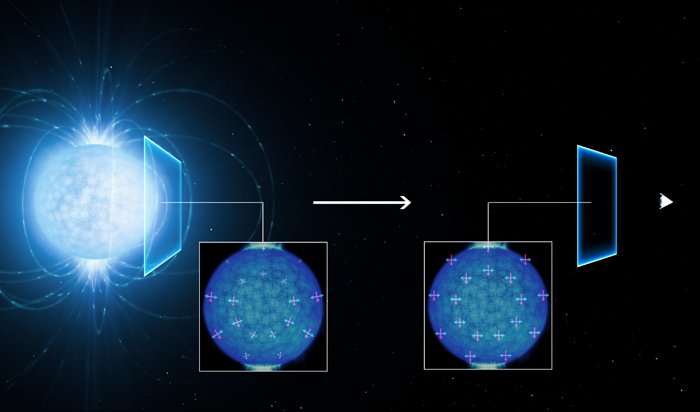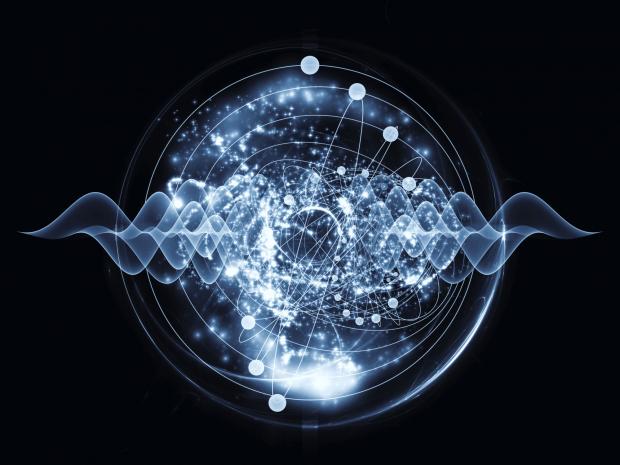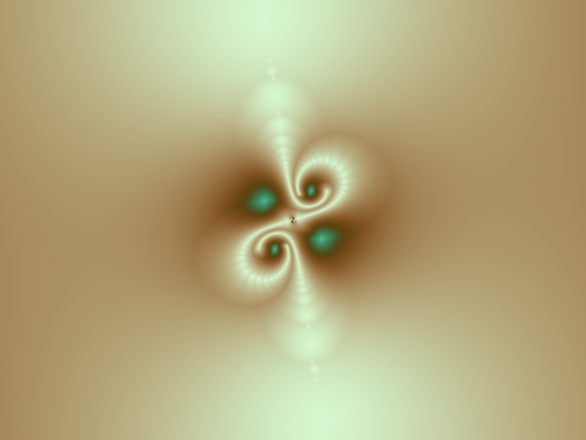At the Quantum level, the stuff we call ‘matter’ vanishes and what is found instead is a play of energy, particles that are at once here and not here. On the quantum scale it’s been claimed that the future can change the past, that a wave is simultaneously also a particle, that we simultaneously dwell in a host of parallel dimensions, and that the simple effect of observation can have a direct impact on experimental results. Yet some scientists have claimed that this quantum stuff doesn’t scale up. The quantum effects in our biological systems or in larger dimensions of matter – such as bridge building – get ‘washed out’.
When Quantum Gets Universal
Now, the lid is off the box and Schrödinger’s cat is coming to greet us with the first ever observation of quantum effects playing out on a universal scale – in dimensions far greater than our whole planet. By studying light emitted from a dense and strongly magnetised neutron star using ESO’s Very Large Telescope, astronomers found the first observational indications of a strange quantum effect, first predicted in the 1930s.
This VLT study is the very first observational support for predictions of these kinds of QED effects arising in extremely strong magnetic fields.
The polarisation of the observed light suggests that the empty space around the neutron star is subject to a quantum effect known as vacuum birefringence. Mignani explains: “According to QED, a highly magnetised vacuum behaves as a prism for the propagation of light, an effect known as vacuum birefringence.”
 Neutron stars are the very dense remnant cores of massive stars — at least 10 times more massive than our Sun — that have exploded as supernovae at the ends of their lives. They also have extreme magnetic fields, billions of times stronger than that of the Sun, that permeate their outer surface and surroundings.
Neutron stars are the very dense remnant cores of massive stars — at least 10 times more massive than our Sun — that have exploded as supernovae at the ends of their lives. They also have extreme magnetic fields, billions of times stronger than that of the Sun, that permeate their outer surface and surroundings.
These fields are so strong that they even affect the properties of the empty space around the star. Normally a vacuum is thought of as completely empty, and light can travel through it without being changed. But in quantum electrodynamics (QED), the quantum theory describing the interaction between photons and charged particles such as electrons, space is full of virtual particles that appear and vanish all the time. Very strong magnetic fields can modify this space so that it affects the polarisation of light passing through it.
Among the many predictions of QED, however, vacuum birefringence so far lacked a direct experimental demonstration. Attempts to detect it in the laboratory have not yet succeeded in the 80 years since it was predicted in a paper by Werner Heisenberg (of uncertainty principle fame) and Hans Heinrich Euler.
This effect can be detected only in the presence of enormously strong magnetic fields, such as those around neutron stars.
Roberto Turolla (University of Padua, Italy).

This artist’s view shows how the light coming from the surface of a strongly magnetic neutron star (left) becomes linearly polarised as it travels through the vacuum of space close to the star on its way to the observer on Earth (right). The polarisation of the observed light in the extremely strong magnetic field suggests that the empty space around the neutron star is subject to a quantum effect known as vacuum birefringence, a prediction of quantum electrodynamics (QED). This effect was predicted in the 1930s but has not been observed before. The magnetic and electric field directions of the light rays are shown by the red and blue lines. Model simulations by Roberto Taverna (University of Padua, Italy) and Denis Gonzalez Caniulef (UCL/MSSL, UK) show how these align along a preferred direction as the light passes through the region around the neutron star. As they become aligned the light becomes polarised, and this polarisation can be detected by sensitive instruments on Earth.




